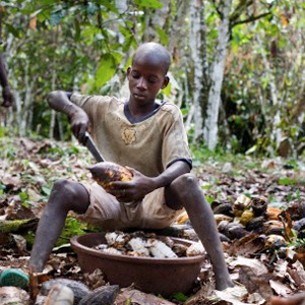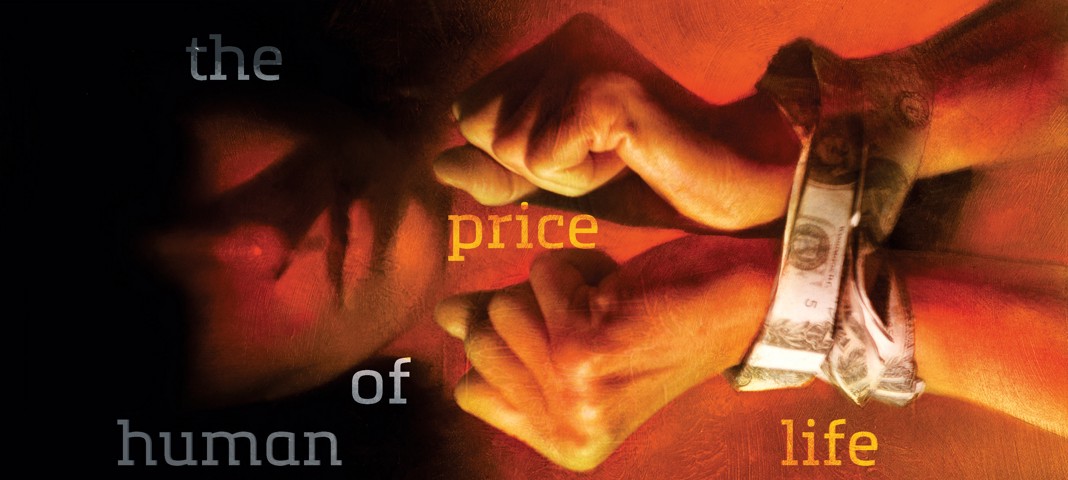Tears rolled down his cheeks as he sat alone on a rickety wooden bench in a town whose name he did not know, waiting for the bus driver to take him to his destination. Haze from the heat melted away the separation between the dirt road and the clay-colored buildings that looked like they would crumble in a light breeze.
He was just a boy—not old enough to be allowed to ride his bike around the corner alone if he lived in the United States. But in West Africa, he was old enough to help support his family and had left home alone for the promise of work in the cocoa plantations, money that his family desperately needed to survive.
But it was not work that awaited him. It was slavery.
The sobbing boy was captured on a hidden camera for The Dark Side of Chocolate, a documentary account of human trafficking in the cocoa industry.
Throughout West Africa, where three-quarters of the world’s cocoa is produced, thousands of boys are forced to work 12 to 14 hours a day on cocoa plantations, carrying machetes to hack the crops to the ground and dragging cocoa-filled sacks heavier than they are—all while exposed to pesticides and other dangers. They sleep in rotting sheds, rusted trailers or tattered tents, or have no shelter at all. They are not paid for their work and will only be freed when they are too weak or sick to work, or when they die.
West African boys are not the only child slaves. The United Nations Office on Drugs and Crime reports that 27 percent of all human trafficking victims worldwide are children.
Human trafficking can exist solely on a local level—a man abducts some girls and puts them to work as prostitutes; a farmer kidnaps some homeless boys and works them in his fields; or street kids are forced to join a begging ring. According to the Washington, D.C.-based Polaris Project, the average trafficked laborer earns the trafficker $13,000 a year.
But what makes it a $32 billion worldwide enterprise is that it also exists on an international, organized crime level, rivaling drug trafficking and counterfeiting for sheer volume and profitability.

Largely ignored for decades as a horror of centuries past, slavery—the most basic and total denial of a human being’s rights and dignity—has in recent years become the focus of worldwide efforts to raise awareness and take action to end this relic of more primitive times.
Human trafficking—the term applied broadly to everything from young boys lured to work for nothing in the cocoa plantations of West Africa to runaway girls in America’s cities who are drugged and forced into prostitution—has become the target of comprehensive studies by the United Nations, the U.S. Justice Department and numerous other governmental and nongovernmental agencies.
The Walk Free Foundation’s Global Slavery Index estimates the number of people enslaved worldwide today at 29.8 million—men, women and children treated like cattle or worse in a business with ruthless “recruiters” who supply unwilling and unwitting individuals to serve corporations and farmers as well as the sex trade in America and globally. The index ranks India, China, Pakistan and Nigeria highest in numbers of enslaved people, while Mauritania, with a population of only 3.8 million, rated worst in slavery’s prevalence, with estimates of 140,000 to 160,000 enslaved. That’s followed by Haiti, with an estimated 200,000-220,000 slaves among its population of 10.2 million.

Mexico, too, has one of the most severe trafficking problems in the world. Data from the website InSightCrime.org estimates that Mexico now sees 800,000 adults and 20,000 children trafficked for sexual exploitation annually. If there is good news to be found in such harrowing statistics, it’s that the figure is down from the 1.2 million estimated trafficking victims in Mexico in 2010.
But in that nation, more than perhaps any other on Earth, the battle to face down human trafficking is made more problematic by the active participation of the infamous drug cartels. Those gangs have expanded their horizons, so to speak, by moving past their bread-and-butter of drug-running to cash in on the sale of women for sex and slave labor. That’s in addition to taking payoffs from pimps and cathouses operating in their territory.
As one operative fighting against human trafficking in Latin America told Time, “The cartels know that drugs can only be sold once, but women can be sold again and again and again.” (For more about the battle against sex trafficking in Mexico, see the interview with Mexican human rights activist Rosi Orozco.)
Most of the 29.8 million trafficked persons are women and children.
Internationally, some 159 countries have ratified the 2000 United Nations Protocol to Prevent, Suppress and Punish Trafficking in Persons—the “Palermo Protocol,” which declares that “effective action to prevent and combat trafficking in persons, especially women and children, requires a comprehensive international approach in the countries of origin, transit and destination that includes measures to prevent such trafficking, to punish the traffickers and to protect the victims of such trafficking, including by protecting their internationally recognized human rights.”
The Palermo Protocol defines human trafficking as “the recruitment, transportation, transfer, harboring or receipt of persons, by means of the threat or use of force or other forms of coercion, of abduction, of fraud, of deception, of the abuse of power or of a position of vulnerability or of the giving or receiving of payments or benefits to achieve the consent of a person having control over another person, for the purpose of exploitation.”
Some countries have initiated legislative action to curb labor trafficking abuses, among them the United States, a destination that represents the land of opportunity to many from impoverished nations.
In the Dominican Republic, for example, traffickers posing as agents for corporations in Puerto Rico, a U.S. territory just 200 miles away, promise workers a job, a place to live and U.S. citizenship—for a fee of several thousand dollars loaned against whatever collateral can be mustered. Once in Puerto Rico, immigrants laboring on shrimp docks or in electronics factories are kept under constant guard. Their pay is garnished to repay their trafficker’s loans—a process that can take years to accomplish, if ever.
Drug dealers turn a profit once at the point of sale. Human traffickers profit repeatedly, often working their victims to death.
Similar scenarios have occurred elsewhere, as in Mississippi and Texas, where numerous lawsuits for human trafficking are pending.
Spurred to action by legislators—mostly women—and community activists, Mexico has embraced legislation aimed at curbing human trafficking.
In West Africa’s notorious cocoa plantations, widespread enslavement of boys as young as 12 is starting to change as chocolate companies agree to certify they use only non-slave labor.
“Human trafficking has been an issue for a long time but it’s become a lot more visible in the last 10 or 15 years,” said Will Marling, executive director of the National Organization for Victim Assistance.
A lot is happening below the radar. What I suspect is that I’m seeing a significant growth because of the more sophisticated tools that are available for identity theft and the ability to migrate people. If I want to bring somebody into the country, I need an identity, so I’m going to steal a Social Security number to make this person look legitimate even though what I’m doing is illegal and clearly an immoral act against another human being.”
On the upside, 150 nations have endorsed the November 2000 Palermo Protocol—the United Nations Protocol to Prevent, Suppress and Punish Trafficking in Persons, Especially Women and Children.
For Marling, a former law enforcement official, the timing is right to make significant change. He believes the opportunity currently exists as never before to impact human trafficking by utilizing broad education to raise awareness of the basic rights of victims.
“If we can grow in our awareness and educate people about the issue with meaningful ways to respond—that’s singularly a powerful opportunity for us.”
Dr. Mary Burke, psychology professor at Carlow University in Pittsburgh, Pennsylvania, and director of the Project to End Human Trafficking, said tough economic times have led to an increase in trafficking, and more education is needed.
“There has been a tremendous increase in public awareness but more needs to be done to fund education programs and victims support programs,” Burke said.































